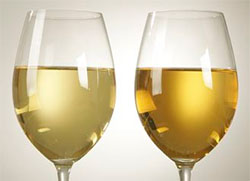The production of wine is like any other mass produced product, there will always be a few problems along the way. The skill is to reduce these to an absolute minimum, but the odd nasty will occasionally raise its head.
Wine problems can occur at so many stages during the winemaking process, and if left uncorrected will appear later on. Tasting a wine is subjective, determined not only by the wines character, but also the individuals likes and dislikes. Some wines will appear sweet to one person and dry to another, the field is broad.
So if you have just had that bottle of Merlot, with tasting notes on the back label that read something like, "ripe red fruit flavours with a savory finish", did you recognize those characteristics? Perhaps you found notes of stewed prunes with demerara sugar instead. Whose tasting assessment was more accurate? Lots of questions, so let's see if there could be a fault lurking or whether the official tasting notes reflected a poetic licence of mythological proportions.
Faults in wine are subject to conjecture. What can generally be regarded as faults may actually be beneficial to certain styles, in fact many of the great wine styles of the world are based on faults of a kind. These include:
- Champagne - a secondary fermentation in the bottle discovered by the monk Dom Perignon.
- Sauternes - the sweet wine get its character from mould on the grapes affected by Botrytis cinera, or noble rot as it's known.
- Tawny Port - a port that is aged in oak casks for an extended time thus undergoing oxidation.
- Vinho verde - goes through a malolactic fermentation which is used to soften wines with higher acidity.
- Flor sherry - the fortified high alcohol wine develops an aerobic yeast growth in the cask.
At lower concentrations, these faults can give depth and complexity, therefore do not appear as faults. On the other hand some characteristics are only faults when they are present in excess.
As wine contains alcohol and acidity, significant levels of bacteria are unable to grow and survive in it. Faulty wine may be unpleasant, but it will not harm you. Let's take a look at the major nasty faults which occur in wine.

- Oxidation (O2): The #1 wine problem, whereby oxygen reacts with various components. In red wines, oxidation can be seen when the colour changes from red to brown, and the nose can become acetic and sour.
- Cork Taint: This used to be a big problem when most of the wines were sealed with corks, but is less so nowadays. A musty taint was imparted into the wine by a compound called 2,4,6 trichloroanisole (TCA) which came from mould growth on the cork bark.
- Sulfur Dioxide (SO2): The use of SO2 has always been used in winemaking, and plays a vital part in wine preservation, however, when used in excess it has a bad side. It can completely dominate the nose of a wine, and can lead to headaches or allergic reactions to those who are vulnerable, especially asthmatics.
- Hydrogen Sulphide (H2S): This potent fault is characterized by the smell of bad eggs. H2S will often react with other components in wine to form related compounds called Mercaptans. These Mercaptans have a range of unpleasant odors, such as 'wet dog hair', 'burnt rubber' or 'sweaty saddles'. H2S is primarily formed by yeast the during fermentation process.
- Volatile Acidity (VA): The term VA describes the presence of excessive amounts of acetic acid or a related compound, ethyl acetate. Acetic acid is the major compound in vinegar, so the aroma will notable, whilst the ethyl acetate is a main component in nail varnish remover. High acetic levels can also cause a sharpness on the palate.
As can be seen from this list of major wine faults - there are numerous others as well - making wine can be fraught with difficulties.
The use of high grade materials, such as stainless steel combined with good all round hygiene has no doubt reduced the incidence of many faults. The best winemaking skills and attention to detail during the fermentation process right through to bottling will limit bacterial growth.
Armed with a sensitive nose and clear palate you will now know how to detect wine faults, should they jump out of the bottle at you!
To learn more about wine, please visit Understanding Wine where you will find more interesting wine information.
EzineArticle Source: How to Detect Wine Faults
By Rob Hemphill
Top 6 Wine Faults - How to Deal With Them

Most of us enjoy a glass of wine after a busy day at work, it's a great way of winding down and relaxing. We are quite used to appreciating the quality of the wine, but what many of us often don't realise is that there is so much that can go wrong throughout the entire winemaking process, even long before it gets bottled.
When we look at a bottle of white wine we get used to seeing that crystal clear, star bright colour, whether it's pale green or rich yellow, it is still remarkably clear. But ask any winemaker, and he or she will tell you that on occasions they have noticed clarity in the bottle turning opaque. A yeast has got in or more accurately by-passed the filtration at bottling time without being noticed - this is how Dom Perignon discovered Champagne. I guarantee nearly all winemakers at some stage of their careers have created a 'champagne' style like this, quite unintentionally. I certainly have!
Let's look at some wine faults and problems that can happen and how to deal with them...
- Before the winemaking stage - Dirty grapes. When the grapes arrive at the winery they must be clean and disease free. If they are not then there is an increased risk of a fault in the form of off-flavours developing later on. Remedy: Extra amounts of SO2 (sulfur dioxide) are required. Clean grapes = clean wine.
- During the winemaking process - Bad flavours. Bacteria in the form of yeasts are responsible for much of the character and aroma of the wine. The winemaker wants to allow these to work away for as long as possible as long as they don't get out of control. It's a sort of high risk gambling game in order to extract the maximum flavour. Leave the yeast too long and harmful aromas can develop, which in serious cases can turn the wine into vinegar. These bad flavours can indicate the presence of ethyl acetate in the wine. Remedies:
- Regular tastings and accurate anti bacterial control are important by inoculating the wine with SO2 at intervals.
- Some aeration may be necessary.
- During fermentation - Stuck ferment. Yeast converts sugar into alcohol which in turn creates heat. The warmer the must (fermenting grape juice) gets, the quicker the yeast works but if the fermentation is allowed to cool down too much, the ferment may not restart and becomes 'stuck'. Remedies:
- A constant controlled fermentation temperature is vital avoiding any fluctuations.
- Use high quality yeasts from renowned sources.
- All stages of winemaking - Oxidation. This is perhaps the most common wine fault where the presence of oxygen oxidises the anthocyanins and other phenols in the wine. This leads to a colour loss and reduced flavour and aroma making the wine flat or as it is commonly referred to as being 'flattened'. Remedy: The addition of SO2 or erythorbic acid by the winemaker.
- Fermentation - Hydrogen sulphide (H2S) This nasty odour is a by-product of the fermenting yeast in a nitrogen reduced environment which is reminiscent of bad eggs. Remedy: Supplement the wine by adding diammonium phosphate as a source of nitrogen to prevent the H2S forming.
- Cork taint is another old enemy in the spoilage of wine. This is nothing to do with the wine, but comes from the chlorine treated cork bark. The fault is partly attributed to the compound 2,4,6-trichloroanisole (TCA) which originates as a mould growth on the bark. Not all corks are affected but enough to make this a very major issue in the wine industry. The cork bark is vulnerable to fungus infections and occasionally the fungus can survive the treatment ready to wreak havoc in the wine. Remedies:
- Better treatment of the cork to combat TCA.
- Use of other forms of bottle closure such as plastic corks and screw caps.
Unfortunately there are more than six faults in wine. Winemakers go to such a lot of trouble to keep problems at bay in the winery, and treat faults as soon as they occur. So, grape growers just remember, produce the best quality fruit you can then at least the winemaker has a good chance of making it into some decent wine.
Like everything, it always comes down to quality and attention to detail. Give the winemaker rubbish grapes, and expect rubbish wine in return!
Article Source: Top 6 Wine Faults - How to Deal With Them
By Rob Hemphill


